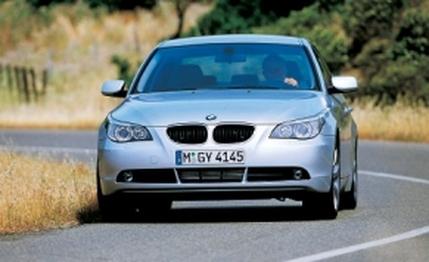
 First Drive Review
First Drive Review
Few new-model unveilings have prompted as much fretting among the enthusiast faithful as has BMW's '04 5-series debut. Maybe that's because most of us don't see much room for improvement in a car whose ride, handling, and performance earned 10Best honors for six years running and first- or second-place finishes in nine of our comparison tests, and attracted paying customers in numbers that increased every year from its 1996 launch through 2002.
So it's little wonder that as rumors surfaced about the new 5-series' iDrive dash, ominous-sounding "active front steering" system, and inflated dimensions (1.3 inches taller, 1.8 inches wider, and 2.6 inches longer on a wheelbase stretch of 2.3 inches), Bimmerphiles became agitated. Some who went on to agonize over design czar Chris Bangle's "flame front" styling wound up in a force-five tizzy.
Well, after two days of intense thrashing over twisting goat paths on the Italian island of Sardinia, we're prepared to lay many of those fears to rest. For starters, Bangle has throttled his "flame" to a sweet spot between bold and beautiful. Crisp lines flow gracefully from front to back, framing surfaces that transition imperceptibly from concave to convex with no jarring interruptions, and a significantly widened track maintains the 5-series' trademark stance.
Inside, the dimensional upgrade buys rear-seat roominess: leg-crossing space increases 1.8 inches, and arm-waving width is up 1.3 inches. The iDrive system has been simplified so that the main menu now controls only four categories (navigation, entertainment, communications, and climate control). Options within each category are listed on horizontal buttons that are chosen by moving the knob fore and aft. Twirling and depressing the knob then selects an item within the submenu. There are fewer functions, and they're more accessible. Some, such as stability control, have even moved back to the more standard dash buttons. There's an optional multicolor head-up display, and a new Bluetooth wireless communications network can link the car's hands-free phone interface with the customer's own cell phone. The air conditioning even monitors humidity levels to prevent drying out occupants' mucous membranes.
To prevent the bulging dimensions from rendering the 5-series obese, BMW forms all bodywork of aluminum from the fire wall forward. Stamped, cast, and extruded parts are arc- or laser-welded together, then bonded and riveted to the remainder of the steel unibody to prevent galvanic corrosion. This construction lightened the front end by about 75 pounds. Bolt-on front-end crash-repair modules keep a lid on insurance premiums. Nearly all the suspension components are aluminum, as is half the driveshaft. Final curb weight is actually a bit less than the previous 5's, and its distribution is an ideal 50/50 front to rear.